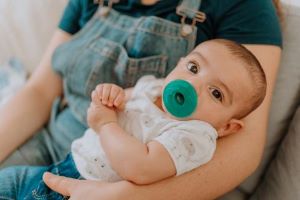
Soothing a fussy baby can be challenging for any parent. I remember the countless times my husband and I would wake up in middle of night trying to comfort our baby. We would make sure he wasn’t hungry, changed his diaper, tried rocking him to sleep, swayed him, swaddled him, and after doing all these things, we weren’t successful in getting him to stop crying. Our last resort would be offering him a pacifier. This helped us calm our baby, but also allowed us as parents to take deep breaths.
We have been asked time and time again, are pacifiers safe for babies?
The answer is yes. According to the American Academy of Pediatrics (AAP), pacifiers can not only help sooth your baby, but research has also proven a pacifier can help with reducing Sudden Unexpected Infant Death (SUID). If you are thinking of giving your newborn a pacifier, AAP advises that parents wait until around 3 to 4 weeks before introducing it.
Consider the following pacifier safety tips before offering a pacifier to your baby:
- If you are breastfeeding, offer a pacifier only once breastfeeding has been established.
- Never hang a pacifier around your baby's neck or attach pacifiers to infant clothing or other objects. Doing so can increase the risk of strangulation.
- If your baby’s pacifier is attached to a stuffed animal, do not let your baby fall asleep with it in the crib.
- Once your baby spits out the pacifier do not force it back in their mouth. Remove it from their crib.
- Use a one-piece silicone pacifier to prevent it from coming apart. Two-piece pacifiers can break easily and can be a choking hazard.
- Replace your baby’s favorite pacifier as soon as you begin to see signs of wear and tear. If your pacifier feels sticky after washing it, it’s time to say goodbye.
Whether you call it pacifier, binky, paci or soothie, it’s important to know not all pacifiers are the same. Pacifiers come in different shapes and sizes. When selecting the right pacifier, make sure you select the right one for your baby’s age. Don’t be surprised if you see small, medium, or large on the packaging. You may need to offer a few pacifiers before you find the right fit for your baby. Once you find the right pacifier for your baby, don’t be caught without one. Having extras available may be a good idea.
As you lay your baby down to sleep, I also want to encourage you to follow AAP’s safe sleep recommendations to help your baby sleep comfortably:
- Always place your baby to sleep on their back. Cribs, play yards or bassinets are safe choices for babies to sleep in.
- Use a fitted sheet and remove extra blankets from your baby’s crib.
- Remove any pillows or soft toys. Your baby’s crib should be bare.
- Room-share for the first 6 months of life.
Pacifiers are helpful when babies are under 6 months. It is easier to slowly wean off the use of a pacifier when your baby is six months of age. As they get older, they may begin to grow more attached to it. Talk to your baby’s pediatrician to learn more on when to stop the use of a pacifier.
If you would like to learn more about pacifiers and how to create a safe sleep environment or cannot afford a safe sleep environment for your baby, click here.
